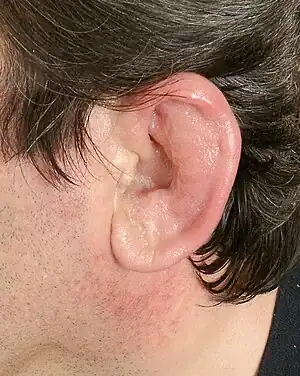Perichondritis of the ear
| Perichondritis of the ear | |
|---|---|
| Other names: Pinna perichondritis, auricular perichondritis, perichondritis auriculae | |
 | |
| Perichondritis of the pinna | |
| Pronunciation |
|
| Specialty | Otorhinolaryngology |
| Symptoms | Pain, redness, and swelling of the outer ear[2] |
| Complications | Cauliflower ear[3] |
| Risk factors | Ear piercing, external ear infections, poor immune function, granulomatosis with polyangiitis[3][2] |
| Diagnostic method | Based on symptoms[3] |
| Differential diagnosis | Otitis externa,[4] cellulitis, relapsing polychondritis, eczema[3] |
| Treatment | Pain medication, antibiotics, corticosteroids, removal of ear piercings, incision and drainage[2] |
| Frequency | Uncommon[3] |
Perichondritis of the ear is a type of infection of the outer ear (auricle), specifically the pinna.[3] It typically results in pain, redness, and swelling.[2] Other symptoms may include fever.[2] The earlobe is generally spared.[3] Complications may include a permanent deformity of the ear, known as cauliflower ear.[3]
The most common risk factor is injury to the pinna, such as from high ear piercing.[3] Other risk factors include external ear infections, poor immune function, and granulomatosis with polyangiitis.[3][2] The infection most commonly involves Pseudomonas aeruginosa or Staph aureus.[3] The underlying mechanism involves inflammation of the perichondrium, the layer surrounding the cartilage of the ear.[3] Diagnosis is based on symptoms.[3]
Treatment includes pain medication, antibiotics, corticosteroids, and removal of ear piercings.[2] Commonly used antibiotics include ciprofloxacin.[3] If an abscess is present this should be drained.[2] With treatment, symptoms should improve in about 3 days, though some discomfort may remain for up to 4 weeks.[3]
Perichondritis of the ear is uncommon.[3] Rates doubled in England between 1990 and 2000 which is believed to be due to an increase is ear piercing.[3] The term come into the English language in the mid 1800s; from the Greek "peri" meaning "around", "chondros" meaning "cartilage", and "itis" meaning "inflammation".[1][5]
Signs and symptoms
Signs of perichondritis or chondritis in people with an embedded earring are similar (these include pain, swelling and erythema of the overlying skin) and fluctuant swelling indicate an abscess that should be drained (typically associated with chondritis).[6] Perichondritis can be differentiated from cellulitis of the pinna, in that the first usually does not involve the earlobe.[6]
In serious cases pus appears between the perichondrium and cartilage. Purulent melting of auricular cartilage takes place. Dead tissue tears away, as a result, auricle deforms and becomes shrunken.
Diagnosis
Perichondritis is within a continuum of disease, with erysipelas and cellulitis being less severe, and chondritis being more severe.[7]
References
- 1 2 "PERICHONDRITIS | Meaning & Definition for UK English | Lexico.com". Lexico Dictionaries | English. Archived from the original on 30 April 2022. Retrieved 29 April 2022.
- 1 2 3 4 5 6 7 8 "Perichondritis - Ear, Nose, and Throat Disorders". Merck Manuals Consumer Version. Archived from the original on 30 October 2021. Retrieved 29 April 2022.
- 1 2 3 4 5 6 7 8 9 10 11 12 13 14 15 16 17 Khan, N; Cunning, N (January 2022). "Pinna Perichondritis". PMID 34283447.
{{cite journal}}: Cite journal requires|journal=(help) - ↑ Wolfson, Allan B.; Hendey, Gregory W.; Ling, Louis J.; Rosen, Carlo L. (2009). Harwood-Nuss' Clinical Practice of Emergency Medicine. Lippincott Williams & Wilkins. p. PT428. ISBN 978-0-7817-8943-1. Archived from the original on 2020-08-01. Retrieved 2022-04-28.
- ↑ "Perichondritis". Academic Dictionaries and Encyclopedias. Archived from the original on 30 April 2022. Retrieved 29 April 2022.
- 1 2 Rodríguez, Javier Ignacio; Thöne, Natalie; Duque, Josefina; Brañes, Rocío (2019-05-31). "Infected transcartilaginous ear piercings. A case report and review of the literature". ARS MEDICA Revista de Ciencias Médicas. 44 (2): 23–25. doi:10.11565/arsmed.v44i2.1550. ISSN 0719-1855. Archived from the original on 2019-06-05. Retrieved 2022-04-28.
- ↑ Watkinson, John C.; Clarke, Ray W. (12 June 2018). Scott-Brown's Otorhinolaryngology and Head and Neck Surgery: Volume 2: Paediatrics, The Ear, and Skull Base Surgery. CRC Press. p. PT2166. ISBN 978-1-351-39899-2. Archived from the original on 30 April 2022. Retrieved 29 April 2022.
External links
| Classification | |
|---|---|
| External resources |